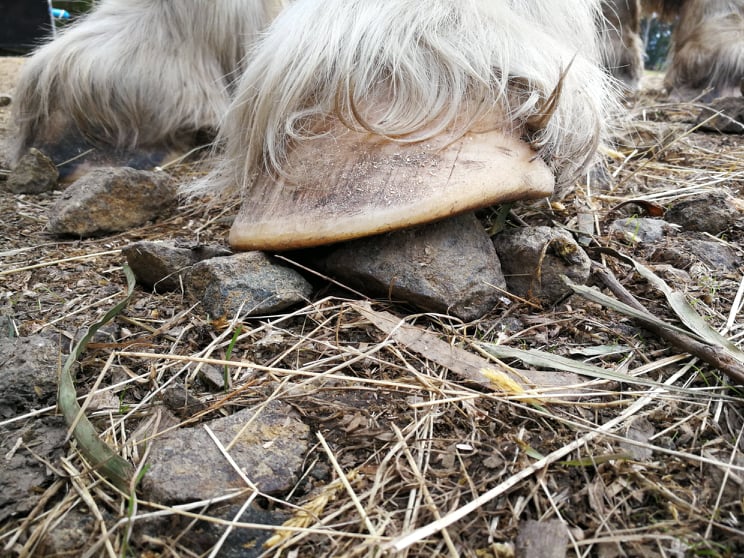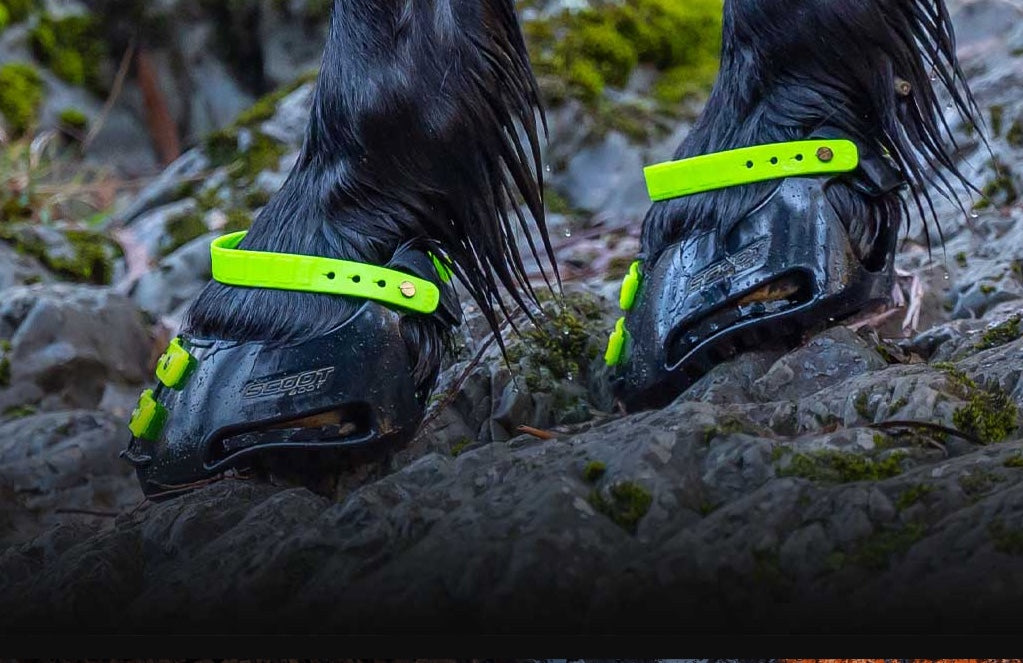
How to Strengthen your Barefoot Horse’s Hooves the Natural Way
Share
Have you just started transitioning to barefoot or are looking for ways to improve the condition of your barefoot horse’s hooves, it is well worth while to take a closer look at the environment your horse lives in. A varied environment that encourages movement can be the key to achieve those rock-crunching hooves you’re dreaming about.
By Helle Maigaard Erhardsen
When going barefoot with your horse it’s important to remember that his hooves will adapt to the environment he spends most of his time in. As such, it is to be expected that your horse could be somewhat footsore when out hacking on gravel or rocky trails, if he’s spending most of his time in a soft, sandy paddock or on thick grass and muddy soil.
However, there are ways to strengthen his hooves naturally to be more resilient on hard, uneven and rockier surfaces. It will take some effort on your side, but it is likely to not only improve the condition of your horse’s hooves, but also make for a much happier and healthier horse in general.
One way is to make your horse’s home environment, his paddock, resemble life in the wild as closely as possible. And with a little imagination, this is possible on even small pieces of land and on a few acres of paddock. In the following, we will look at different ideas on how you can improve your paddock environment to make your horse happier and more fit, whilst building strong and healthier barefoot hooves.
First step to healthy hooves: Get your Horse moving!

Natural hoof care professionals agree that the key to healthy hooves is a combination of 1) sufficient exercise and movement, 2) a forage based diet balanced with essential vitamins and minerals, and 3), regular qualified hoof trims. In this blog, we will look closer at the first part - which of course - should be combined with the other two parts for the best result.
When you look at horses in the wild, it becomes evident why daily movement and exercise is essential for your horse. Free roaming wild horses travel between 15 and 20 kilometres per day in search of forage and water. This amount of exercise stimulates the horses’ metabolism, their agility and overall fitness and health.
Additionally, wild horses’ hooves adjust to the environment they move across and their hooves will grow according to how quickly the natural environment wears them down. That is why wild horses rarely suffer from the common hoof issues of domesticated horses and why wild horses don't need to be trimmed by a farrier.
According to the Barefoot Blacksmith Andrew Bowe, it is miles under saddle that grows the best hooves in domesticated horses. In his experience, it is commercial trail horses and endurance horses that have the healthiest and strongest bare hooves. However, far from all horse owners are able to exercise their horses to the same degree as endurance horses are. As such, it is useful to look at what you can do to encourage movement where your horse spends most of his time - in his paddock.
Encourage your Horse to Move with a Track System

After observing how the wild mustangs in the U.S. Great Basin are following trails when moving around in their territory, Jaime Jackson developed the concept of a Paddock Paradise. The idea is to mimic these natural trails in your horses’ paddock by setting up a fenced off track around the perimeter of your property that eventually can lead to an open paddock in the middle.
Research shows that compared to turnout in a regular open paddock, horses move more miles and more frequently when on a track system. The reason for this is that the horses will need to travel between feeding stations, water supply, rolling spots, sheltered areas and pasture. As such, when designing your paddock paradise, you need to be strategic in placing these features as far apart as possible. Plenty of small hay nets well spaced apart is also more effective than one large hay feeding station.
The amount of daily exercise will further increase if you can incorporate hills in your track system. If your land is flat, there is always the option of creating hills yourself with compacted dirt piles similar to mountain bike tracks, so your horse can exercise some different muscle groups by going up and down.
Another effective way to sneak in some gymnastic exercises is by placing natural obstacles on the track. This could be poles on the ground to make the horse lift its feet or even large tree trunks that require the horse to jump or perform some nice, high knee lifts. Keeping more horses together on the same track will also increase movement, as they will then be able to practise natural herd behaviour such as playing, following each other and grooming.
Use the Track Surface to Condition your Horse’s Hooves

Pea gravel is a popular surface on track systems as it is gentle on the horses’ hooves whilst providing great stimulation for their soles and frogs. Here it is used as footing in a shelter and around a water station at Stepping Stone Equine Hoof Care to help rehabilitate a horse suffering from navicular.
Apart from mere exercise, a track system provides you with the perfect opportunity to condition your horse’s hooves on different surfaces. Daily exposure to a variety of surfaces is crucial for achieving strong, resilient barefoot hooves. As mentioned, horses' hooves are highly adaptable to their environment and if only ever exposed to spongy arena bedding and soft grass in the paddock, your horse is likely to be somewhat footsore on rougher surfaces.
As such, it is really useful to put down a variety of surfaces on the track that your horse travels on daily to get to his desired destinations. Paving the ground with large rocks around the drinking station is a popular feature, which will not only help to keep the ground dry and mud free, but will also make your horse walk across it and stand on it as he’s drinking.
Rough gravel tends to be harsh on sensitive hooves but is nonetheless a great surface to further condition already healthy barefoot hooves. A less harsh version is pea gravel, which consists of small, pea sized rounded rocks. Pea gravel is suitable for both healthy hooves and hooves that need rehabilitation or conditioning during the transition from shod to barefoot.
If you are utilising your track system to limit and manage your laminitis prone horse’s grass intake, you might not want to give him access to a grassy area. Although he would still need a soft place to lie down for a sleep or a roll. Although many horses love sand for this purpose, it can be difficult to keep in place in times of heavy rain or wind. Sandy loam or fine soil will also do the trick and is easier to control.

Mud is not only a dangerous slipping hazard but also the most unhealthy substance for horse hooves. Mixed with manure and urine it becomes a potent bacteria cocktail and constantly soaked hooves become soft and susceptible to infections and bruising. Here are non-slip pavers being packed with road base gravel to provide a dry surface for the horses around a hay feeder.
Hoof Boots for Gradual Conditioning and Stimulation of Sensitive Hooves
Many common hoof issues are related to the horse compensating for soreness, which leads to toe-first landings and under-stimulated heels and frogs. If the heel soreness is caused by an infection such as thrush, this obviously needs to be treated. Otherwise, although it seems paradoxical, gradual stimulation of the sore tissue is the best way to rebuild it.
Although it must depend on the condition of your horse’s hooves as to how quickly you should expose him to stimulation from different surfaces. Thin soles and sore, contracted heels should be protected with hoof boots until they have had time to grow better. The advantage of using hoof boots such as Scoot Boots, is that these boots will still allow hoof stimulation from the ground, which is essential to stimulate healthy growth of the affected tissue.
Once you have a consistent, comfortable heel-first landing in protective hoof boots, you should start to gradually let him be turned out without boots on an appropriate surface. Depending on your horse’s hoof condition, he might always be most comfortable in hoof boots when you’re riding on rocky surfaces. That is perfectly normal, as it takes a lot of consistent exposure to harsh ground for your horse to achieve as hard, rock-crunching feet as wild horses have.

Building a Supportive Barefoot Community
The team at Scoot Boot believe passionately in the barefoot horse and strive to build a supportive community of barefoot horse lovers.
Find more information about using Scoot Boots here.
|
About the author
Helle Maigaard Erhardsen is an investigative journalist specialising in environmental issues. Her devotion to the outdoors includes a life long passion for horses of which she has two: Pannigan, an off-the-track Thoroughbred and Audrey, a Shetland pony, who are both bitless and barefoot. Helle is born in Denmark, where she graduated from the Danish School of Media and Journalism in 2015. Her work is characterised by comprehensive research and she was nominated for the special media award Bording Prisen for her investigative reporting with the newspaper Ing.dk. She later obtained a Master’s degree in Journalism, Media and Communication from UTAS, when she relocated to Tasmania. |

